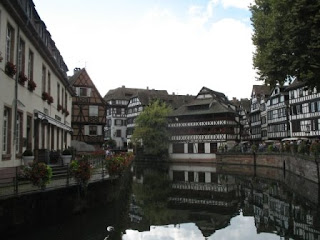On Friday, Stefan and I drove south to Staufen, then east, past Münstertal, and into the hills...

where we parked and began our hike up the beautiful...

Belchen (1414m). A helpful trail sign left little doubt about what direction we should take, until we encountered this...

fork just a dozen meters up the road. Stefan wisely checked the map, but it didn't show the fork, so we stayed to the left until...

we were strongly advised to go to the right. We had one last view of the...

valley behind us, where lay nestled the tiny village Kaltwasser, before we headed into the...

mossy...

woods. We saw nothing but trees, switchback after switchback, until at long last we emerged...

atop the ridge, with water vapor still burning off the mountain in the warmth of the late morning sunlight.
The Belchen is clearly a lovely place to spend the summer if you are...

a sheep or a goat or...

a cow.
We opted for...

a more open route back down, and observed that folks on the Belchen enjoy a little more flourish than those on Schauinsland when it comes to...

stacking wood. After we walked back through...

Kaltwasser to our rental car, we decided to drive to...

Staufen for some coffee, seltzer, and ice cream. I believe Germany is one of the only countries in the world where one can make an occasion of
going out for seltzer.
We made it back to Freiburg in good time to see...

the play Elias's summer camp put together. The play is about a king who locks up his daughter because she doesn't want to get married; but then he begins to have regrets and sends a dragon from Toulouse to look after her. First the dragon has to track down the princess; a rabbit is unable to help, and the dragon subsequently receives conflicting directions from two foxes (shown above). Eventually he learns that the princess has been stolen from her tower by a band of robbers; the dragon rescues her and...we have to go back next Friday to see how the story ends, since the play isn't done yet. (Elias won't be in camp next week, so he'll be in the audience rather than on stage.)
Can there be a better way to top off a great day than to go see...

your two favorite German soccer teams face off in an exhibition game at a small town field in Bahlingen am Kaiserstuhl? How fortuitous that we happened to be in town during the Kaiserstuhl Cup! SC Freiburg beat 1860 Muenchen, 2:0, scoring a dramatic second goal just before the clock ended. Other highpoints of the evening included two storks flying over the field into the setting sun, and the absence of vuvuzelas.

 We began by heading south to Loerrach, because I was determined to satisfy my romanticist ruins itch after our triple-whammy failure in Elsass. Nestled on a hill overlooking Loerrach is the formidable Burg Roetteln, third largest ruined fortress in all of Baden. Like pretty much every other ruin in the region, Roetteln dates to the 12th century or so C.E., after which it was happily occupied, renovated, taken over, conquered, reclaimed, expanded, yadda yadda, over the subsequent four or five hundred years. Impressively, it outlasted many of its peers, having the honor of not being permanently trashed until the late 17th century, when, under the reign of Louis XIV the Sun King, French troops sacked it during the Franco-Dutch war.
We began by heading south to Loerrach, because I was determined to satisfy my romanticist ruins itch after our triple-whammy failure in Elsass. Nestled on a hill overlooking Loerrach is the formidable Burg Roetteln, third largest ruined fortress in all of Baden. Like pretty much every other ruin in the region, Roetteln dates to the 12th century or so C.E., after which it was happily occupied, renovated, taken over, conquered, reclaimed, expanded, yadda yadda, over the subsequent four or five hundred years. Impressively, it outlasted many of its peers, having the honor of not being permanently trashed until the late 17th century, when, under the reign of Louis XIV the Sun King, French troops sacked it during the Franco-Dutch war.
































































